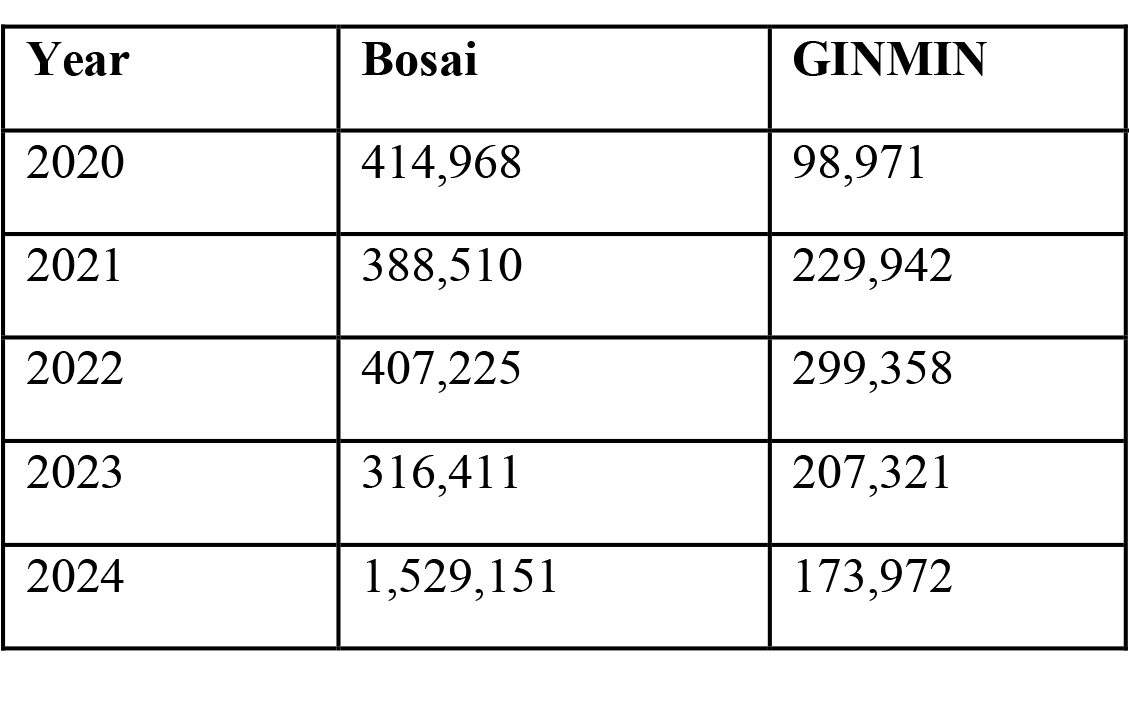-fuelled by Bosai investments
Government yesterday announced that bauxite mining here is making a comeback as last year saw a groundbreaking increase in output of some 225 per cent as compared to 2023, with 1.7 million tonnes produced from the two foreign companies that work here.
“Bauxite has been a success story over the last few years. In 2023, the production of bauxite was at 523,732 tonnes,” Minister of Natural Resources Vickram Bharrat said during his ministry’s end of year press conference.
As per Stabroek News’ request, the Minister gave the production figures of the two bauxite producing companies here over the past five years.
The table below gives production information in tonnes for Chinese owned and operated Bosai, and Canadian subsidiary, GINMIN.
Giving some insight into the sector, the Minister echoed most of what President Irfaan Ali stated earlier this month, saying that while the pullout of Russian-owned RUSAL saw a 40 per cent decline in production and over 500 jobs lost, revitalisation from the two companies has now seen double that figure employed
Ali had posited that the government is upbeat about the prospects of increased bauxite production here this year as the Bosai Minerals Group had been granted additional land to mine that would see increases to 250,000 tonnes and 400,000 next year, along with 1,000 people being employed by March.
“The government had issued additional reserves in Kara Kara which approximates 3.5 million tonnes… additional investments by Bosai Minerals Group, along with the issuance of additional reserves will see production increase by over 250,000 tonnes this year and 400,000 tonnes next year,” the President had said as he gave an overview of plans for the bauxite and forestry sectors.
However, at that time, bauxite production figures for the companies that operate here were not given, nor was the overall 2024 production.
As it relates to employment, the President said that 500 people were expected to be employed by the company last year and another 500 by March of this year, following the installation of a new kiln in Linden. It is unclear how much of the 2024 target has been achieved.
“The installation of a new kiln in Linden, the first of its kind since the 1970s and introduction of new metallurgic acid grade bauxite, will also transform the sector and Project Linden,” he said.
Export of the mineral, he said, is expected to increase this year to 163.2 million tonnes.
Ali charged that the “bauxite sector collapsed under the APNU+AFC government,” as he pointed to his analysis that between 2014 and 2020, total production contracted. “Production went down by 40 per cent. More than 50 per cent of those employed [in the bauxite sector] lost their jobs between 2015 and 2020,” he said, pointing to the closure of the Russian company RUSAL.
He said that since his government took office, a number of steps were taken to resuscitate the sector.
“We had to build back the sector and reenergize what was lost in the region. We went about implementing policies to broaden the product range and increase production, and (homed) in on giving the company additional reserves.”
He said that Bosai undertook to construct a US$470 million aluminium plant that is expected to provide hundreds of jobs in Region Ten.
Tailored
The President assured that he remains committed to not only ensuring there is private sector development tailored for the benefits of citizens, but to also “protect the rights and improve conditions of service for workers in large mining companies.”
He had also repeated much of what Senior Minister in the Office of the President with Responsibility for Finance and Public Service, Dr Ashni Singh had said when he presented the 2024 Budget, as he predicted that this country’s bauxite industry was set for major growth, with new reserves and investments.
The importance of the bauxite sector in the medium and long term was highlighted with Singh noting that despite facing challenging market conditions in 2023, active measures had been taken to alleviate costs, expand the product range, and boost production. These efforts were predicted to bring about a significant turnaround in the bauxite industry last year.
Singh had pointed out that one of the standout developments was the allocation of additional reserves in Kara Kara, which amount to 3.5 million tonnes. Those reserves he too then noted, were expected to increase production by Bosai Minerals Group in Linden by more than 250,000 tonnes in 2024 and 400,000 tonnes in 2025. The existing kilns as well as the newly installed kiln number 15 will be supplied by these reserves. The Finance Minister pointed out that kiln number 15, which was put into operation in June 2023, marked the first new kiln in Linden since the 1970s. It has received a US$120 million investment.
Additionally, the deployment of kiln number 15 and the introduction of the new metallurgic grade bauxite (MAZ) project are poised to transform the Linden area. Currently, the company has invested US$30 million in procuring mobile equipment, including hydraulic excavators, dump trucks, crane trucks, a water truck, and graders, specifically for the 2024 operations.
Moreover, he had stated that a nine-kilometre conveyor system will link the new mine in Linden to a new port, and from there, the bauxite will be barged through the river. These modern self-propelled barges, with a capacity of 13,000 tonnes, have more than double the capacity of previous barges.
Singh also noted that to reduce energy costs, a 19-megawatt solar farm will be installed and is expected to supply both operations and the local community by the end of 2024. These investments are not only set to revolutionise economic activities in Linden, but also support community power generation, benefitting the construction and service sectors, as well as residents.
As a result of these initiatives, a production of 4.5 million tonnes a year was projected, with one million tonnes expected to be achieved by the end of 2024. Furthermore, over 500 new jobs were anticipated to be created in 2024, with an additional 500 by the first half of 2025.










